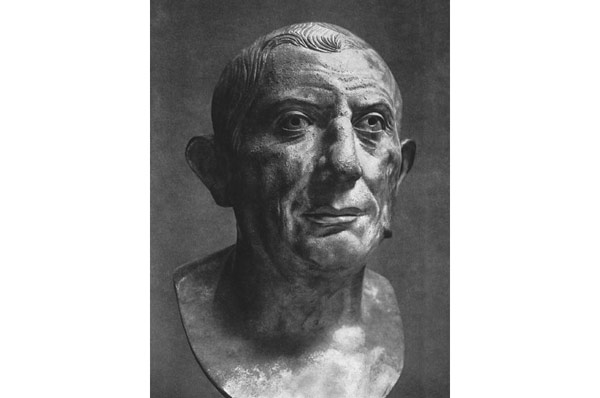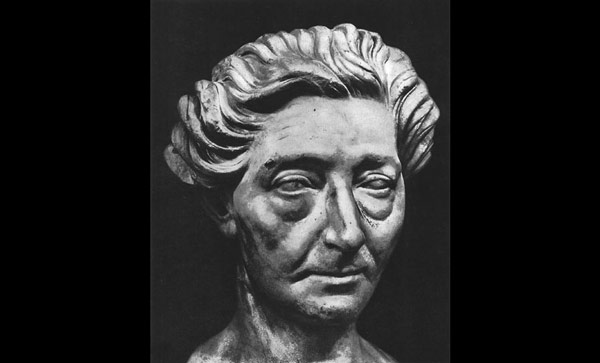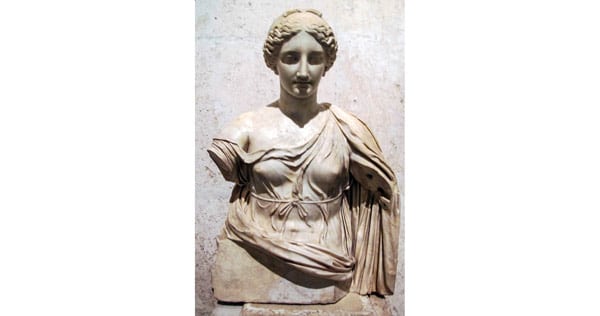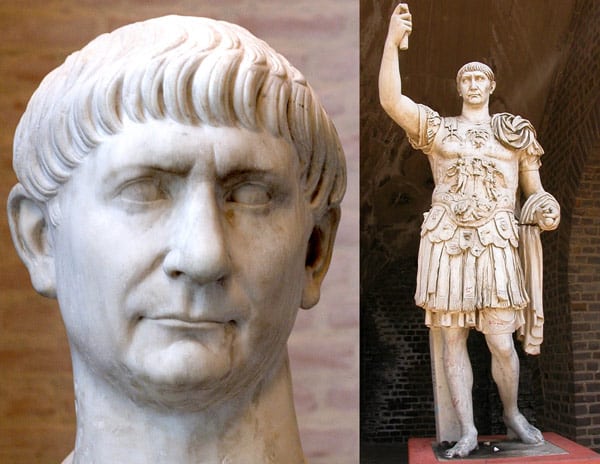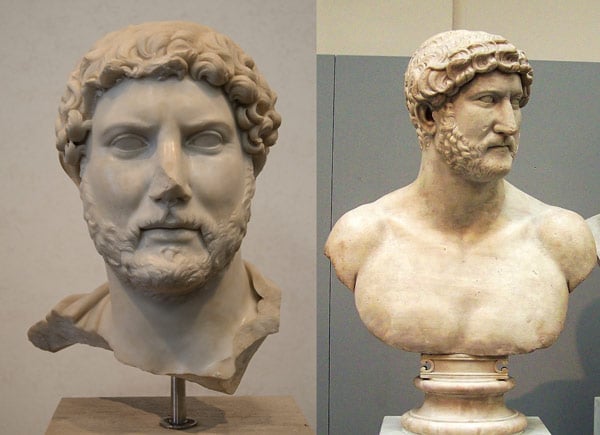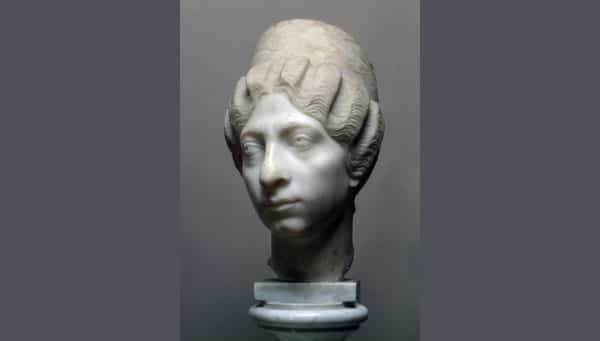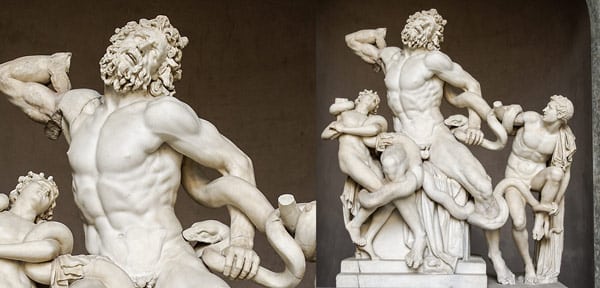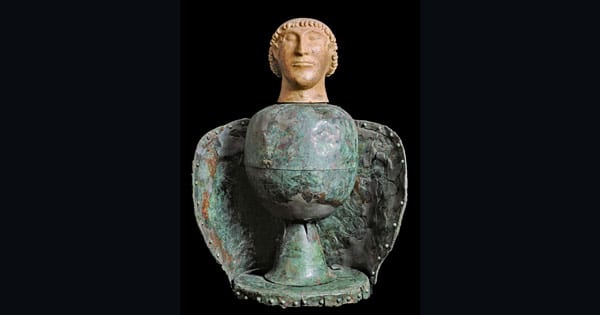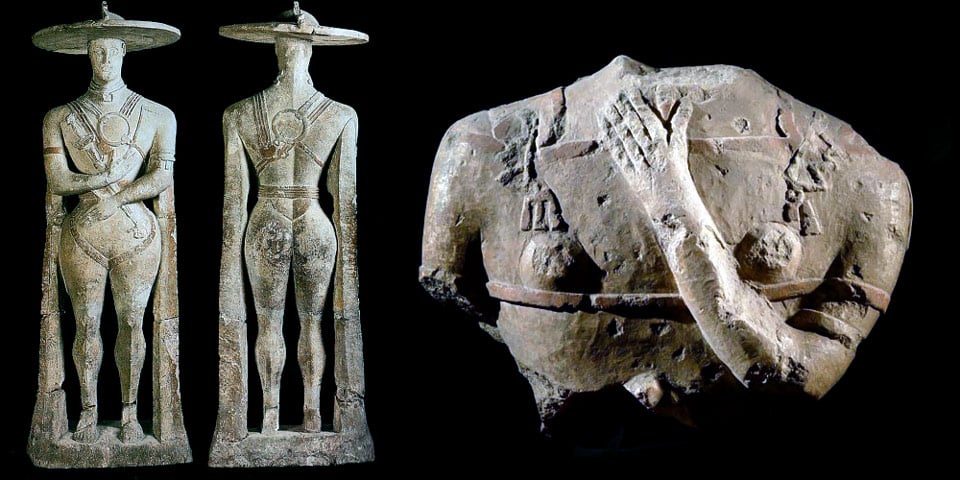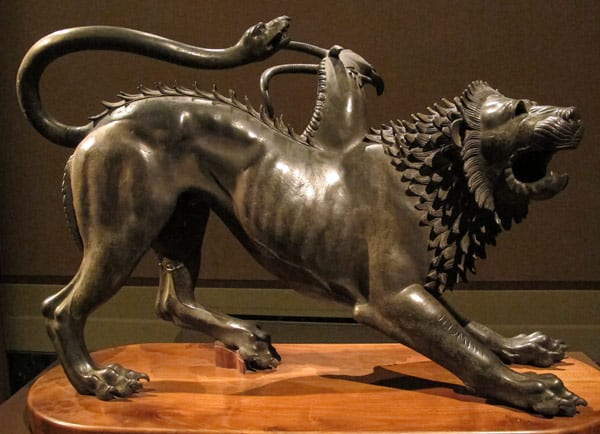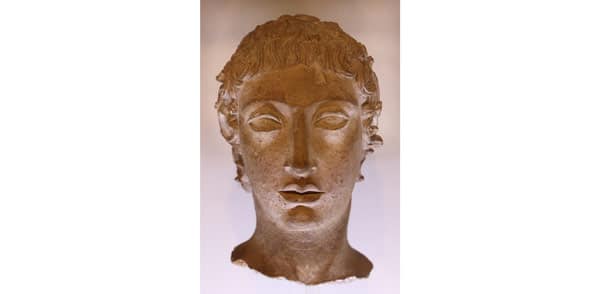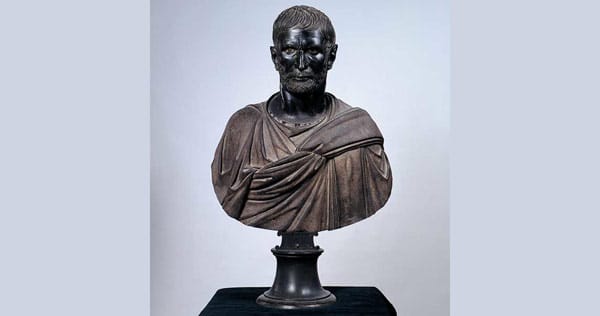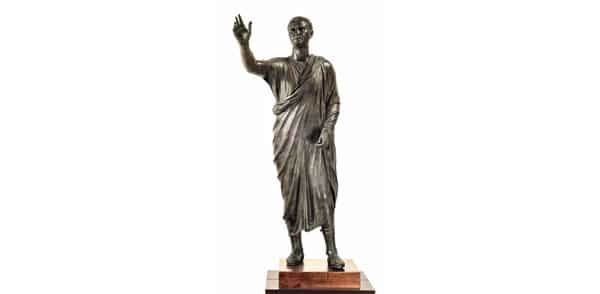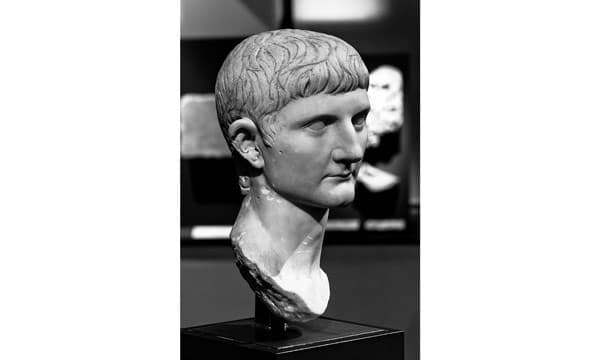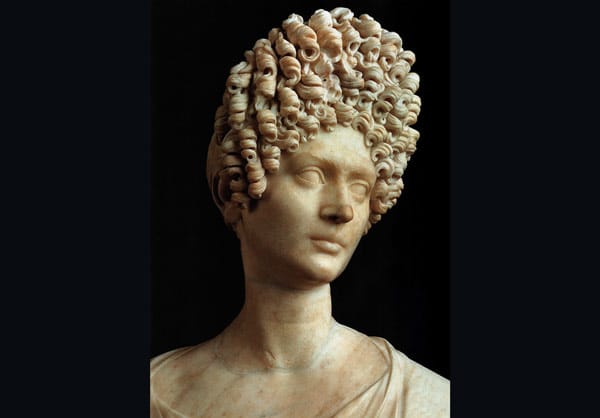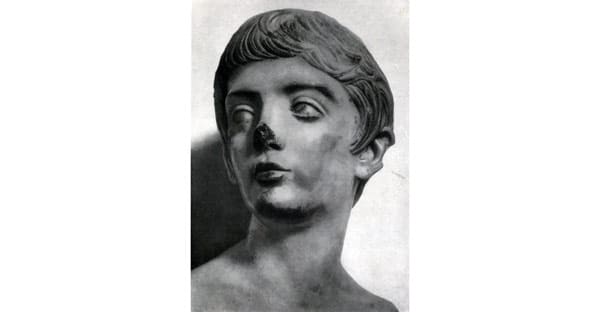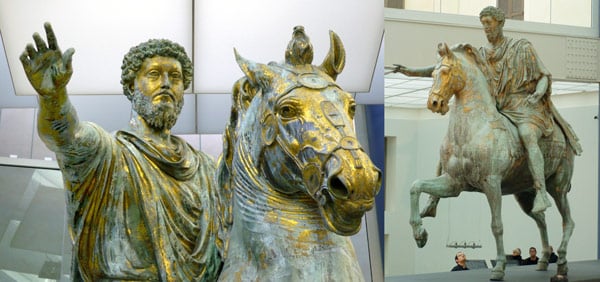Until the 20th century, the history of ancient sculpture was structured in chronological order – first Greece (the peak of art in the 5th-4th centuries BCE), followed by Rome (the pinnacle of its rise in the 1st-2nd centuries CE). The art of Ancient Rome (Roma) was considered a late expression of Greek cultural traditions, representing the culmination of the ancient period.
After the publication of works by art historians Ranuccio Bianchi-Bandinelli and Otto Brendel, scholars of antiquity recognized Roman art as a distinct and unique phenomenon. The sculpture of ancient Rome came to be regarded as a school of classical craftsmanship, with its history yet to be fully written.
Page Contents
The Development of Roman Art (8th to 1st centuries BCE)
In the 8th century BCE, ancient Roman artists departed from the traditions of Hellenistic sculptors and began to explore their own creativity.
The history of ancient Roman art can be divided into four stages:
- The earliest period (8th-5th centuries BCE)
- The Republican period, a period of formation (5th-1st centuries BCE)
- The flourishing of Roman imperial art (1st-2nd centuries CE)
- The crisis period (3rd-4th centuries CE)
The origins of ancient Roman sculpture can be traced back to the art of the Italic and Etruscan peoples, who created distinctive cultural monuments. The most famous artifact is the Warrior of Capestrano (Guerriero di Capestrano).
In the earliest period, sculptors created portrait images and stone reliefs that differed in quality from Greek works.
Terracotta sculpture in temples developed with decorative and cult functions. Large statues of gods emerged, surpassing Greek sculptures in size. In 1916, magnificent terracotta statues of Apollo, Hermes, and Venus were discovered in the ancient Etruscan city of Veii. These statues were created for the exterior decoration of the Temple of Apollo (550-520 BCE).
Features of Sculpture of Ancient Rome
Roman masters departed from the traditions of Greek sculptors and did not create idealized human figures. Individuality permeates the entire history of Roman portraiture, rooted in the religious custom of creating posthumous masks.
Patricians had the right to keep the likeness of their deceased ancestors in their homes. The more portraits they possessed, the more distinguished their lineage. This explains the characteristic traits of Roman sculpture: realism, specificity, knowledge of facial expressions and musculature.
The works are characterized by emotional coldness and detachment. The open plasticity of Greek sculptures is contrasted with the image of a Roman covering his head with the edge of his clothing during prayer.
Greek masters depicted archetypes of human figures: athletes, philosophers, and military commanders. Roman sculptors created portraits in the spirit of extreme naturalism, emphasizing the qualities of a person’s character and their individual features.
To the Greek models of plastic art (statues, herms), Roman sculptors added a new form of portraiture – the bust.
Unlike the Greeks, Roman sculptors associated their art with poetic myth. The Roman sculptor perceives the world in distinct forms.
In contrast to the Greeks, during the Late Republic period (264-27 BCE), the Romans were less engaged in monumental sculpture. They preferred bronze statuettes of prominent figures and gods.
Decrees of the Senate regulated the size, material, and character of the statues. Equestrian and armor-clad portraits could only be erected in the case of military triumph. The task of sculptors was to capture the familial, ancestral features, social rank, and status of a Roman.
Many works are identified or have inscriptions on the pedestal providing information about the model, but the names of ancient Roman portraitists have not been preserved.
Types and Genres of Sculpture of Ancient Rome
The types and genres of ancient Roman sculpture can be classified as follows:
- Relief sculpture (high relief and low relief)
- Round sculpture (statue, bust, composition, statuette)
Scholars in the field of ancient studies have identified the main genres of Roman sculpture:
- Historical;
- Mythological;
- Allegorical;
- Symbolic;
- Battle scenes;
- Portraiture.
One of the primary forms of visual art in Rome is relief sculpture. Artists are inclined towards analysis and detailed portrayal of figures, accurately documenting historical events. The grandiose Altar of Peace in Rome (13-9 BCE) and the reliefs of Trajan’s Arch in Benevento (114-117 CE) are considered masterpieces of the early Principate period.
Characteristics of Sculpture During the Period of Its Flourishing
The change of imperial dynasties influenced the stylistic characteristics of ancient Roman sculpture.
The Principate of Augustus
Antiquarians refer to the reign of Octavian, known as Augustus (Octavianus Augustus), as the “Golden Age” of the Roman Empire (27 BCE – 14 CE).
The strict forms of Greek sculpture from the classical period served as an example for the ruler in creating a magnificent empire. In portrait sculpture, individual features were softened. The standard became a general appearance that pleased the Principate.
The idealization of the image is well seen in the statues placed in the Forum in front of the Pantheon, the Roman temple of Mars the Avenger. In 1863, a two-meter-tall bronze statue was found at Prima Porta, commissioned by the Roman Senate.
Augustus is depicted as a majestic descendant of the gods, with Cupid on a dolphin at his feet. The relief on his armor tells the people about the emperor’s victories in numerous battles (Chiaramonti Museum, Vatican).
The sculptors create independent female portraits and for the first time, sculptural representations of children emerge. On the left relief of the Ara Pacis, the beautiful Goddess Tellus holds two infants on her lap, surrounded by figures of well-fed animals.
The art is meant to glorify the prosperity of Rome under the first emperor.
- I recommend reading about the rise of Octavian.
The Period of Julio-Claudians (27 BC – 68 AD) and Flavians (69 AD – 96 AD)
During the rule of the Julio-Claudians and Flavians, monumental sculpture takes center stage. The glorification of power led to the masters even giving the gods the characteristics of the emperors.
Realism first appears in portraits. For example, the statue of Claudius consists of two different parts: the head with a realistic depiction of the aging face of the great pontiff and the ideal figure of the Greek god Jupiter.
The ruler’s appearance is shown through volumetric modeling: a broad forehead with wrinkles, sagging face, protruding ears.
The new style replaced the smoothness of individual features in portrait busts with a realistic representation of Roman emperors. Marble portraits are painted on the lips, and the eyeballs are tinted with ivory. In bronze busts, semi-precious stones are inserted into the pupils to give them a gleam (portrait of the cunning moneylender Pompeia Lucceia from Pompeii).
The genre of female portraiture develops in two directions: classicistic and “veristic.” Ruthless truthfulness is reflected in the portrait of an elderly Roman woman (Vatican Museums, Gregorian Profane Museum).
The gaunt and restless face, wrinkled forehead, and bags under tearful eyes speak of impending old age. The female figure is depicted differently in the statue of an unknown woman found near the ancient Porta San Sebastiano.
The partially nude Roman woman is depicted as Aphrodite. She proudly arches her posture, tilts her head, and extends one foot forward, covered with draped fabric. The portrait head of the mature and authoritative Roman woman hardly corresponds to the ideal figure of the goddess (Vatican, Capitoline Museums).
The Time of Trajan (98-117) and Hadrian (117-138)
During the reign of Emperor Trajan and Hadrian, sculpture continued to express the grandeur of the Empire. The use of different forms defined two stages of artistic development: Trajanic and Hadrianic.
Emperor Trajan (Marcus Ulpius Nerva Traianus) returns to the traditions of the Republic. Sculptors are required to replace lavish decoration with cold and dry forms. Sculptors glorify Trajan as an outstanding military commander and ruler.
The heroic interpretation of the image is in line with official ideals. The portrait style is characterized by a lack of emotionalism. The images remain expressive, exalting the stern, ascetic, and dedicated individuals devoted to the state. A new form of sculptural art emerges, the “great bust.” Three-dimensional forms are used only in the portraits of Trajan.
Roman Emperor Hadrian (Publius Aelius Traianus Hadrianus) was influenced by the art of ancient Greece.
The sculptors present harmonious and perfect figures in their works, reminiscent of the Greeks. The subjects change, and there is an intensified mythological interpretation of the figures, as well as the depiction of nudity. The reliefs portray scenes of hunting and sacrifices to the gods. The main characters become the emperor and his favorite, Antinous. The youth is depicted as a deity or a hero of myths. In portraits, individuality and facial accuracy disappear. The sculptors often portray the emperor as Aristotle.
- I recommend reading about the columns of Ancient Rome
Time of the Last Antonines
During the reign of the emperors Antoninus Pius (Titus Aurelius Fulvus Boionius Arrius Antoninus Pius, 138-161 AD), Marcus Aurelius (Marcus Aurelius Antoninus, 161-180 AD), and Commodus (Lucius Aelius Aurelius Commodus, 180-192 AD), the art of portraiture flourishes. This creative surge lasts for one and a half centuries. Equestrian statues emerged, setting the standard for subsequent equestrian monuments in Europe.
Sculptural art showcases the individuality of the person and their spiritual strength. The portraits of Antoninus Pius and Marcus Aurelius provide a psychological characterization, depicting philosophical contemplation, skepticism, and concern. Masters employ expensive materials such as gold, silver, and rock crystal. Portraitists use a particular technique, aiming to resemble the artistic image to reality.
To create the volume of hair curls, drills are used, and the polishing of the facial surface employs a play of light and shadows. For example, a portrait of a Syrian woman made of polished marble appears like a precious gemstone.
Any irregularities in facial features are overshadowed by the radiance of the woman’s inner beauty, delicately conveyed by the sculptor (the artwork is housed in the Hermitage Museum).
The Crisis Era (3rd-4th centuries AD)
Contradictions between imperial ideology and the harsh reality intensify. The slogans of power promoting freedom, happiness, and equality become irrelevant in the conditions of a crumbling empire. The aura of the emperor as a representative of divine authority diminishes. The style of Roman sculpture undergoes a transformation:
- Ancient ideas are replaced by new Christian ones.
- Female and child portraits are rarely created.
- Sculptors abandon the idealization of figures (e.g., the portrait of Emperor Nero).
- A sense of wariness, suspicion, and tragedy dominates.
The Most Famous Sculptures of Ancient Rome
The bloody events erased the names of sculptors from history. Only the Etruscan master Vulca is known, who worked in the late 6th to 5th centuries BC and was mentioned by the ancient writer and encyclopedist Pliny.
Capitoline Wolf
This bronze sculpture was created in the 5th century BC. The monument of Etruscan art depicts a she-wolf (Lupa Capitolina) nursing two infants.
The future founders of Rome, Romulus and Remus, whose parents were the god of war Mars and the vestal virgin Rhea Silvia, became hostages in the struggle for power. Romulus and Remus were thrown into the Tiber River and were found and nursed by a she-wolf, who is called the “mother of Rome.”
The legendary sculpture, with its inaccurate proportions and primitive depiction, stands out for its sharp dynamism and temperament. The dating of the Capitoline Wolf sculpture is a subject of debate among scholars. It is believed that the bronze images of the twins were made in the 15th century. The work is attributed to the Florentine sculptor of the Renaissance period, Antonio del Pollaiolo.
The main symbol of the city is preserved in the Capitoline Museums in Rome (Musei Capitolini).
The Boy with the Thorn
The Boy with the Thorn (Spinario) is a bronze sculpture of unknown authorship created in the mid-1st century BC. It is a copy of a Greek statue.
Historians interpret the image of the boy extracting a thorn in different ways:
- A Spartan runner who, overcoming pain, was the first to reach the finish line.
- A shepherd boy from the province who was sent with news of an impending attack on the Capitol.
Having fulfilled a noble mission, the adolescent frees himself from the painful thorn.
The author of this genre statue portrays a naked boy with a beautiful muscular body, whose face does not show any signs of suffering. The scene conveys not the drama of the event, but a strong will. Copies of this widely copied sculpture can be found in various museums around the world. The original is exhibited in the Capitoline Museums in Rome (Hall of Triumphs).
I recommend visiting a tour of the Capitoline Museums.
Laocoon and His Sons
The marble sculptural composition depicts the deadly struggle of Laocoon, a priest of the god Apollo, and his sons with serpents.
The work was created in 50 BC, and it is a copy of the original bronze monument created by Greek sculptors in Pergamon in 200 BC. Michelangelo Buonarroti, sent by Pope Julius II to assess the discovery, confirmed the authenticity of the work and noted the incredible dynamism and plasticity of the ancient Roman sculptor’s creation. One of the most famous sculptures of ancient Rome is housed in the Pio-Clementino Museum in the Vatican (Museo Pio-Clementino).
Etruscan Canopic Urn from Chiusi
This clay urn from the 6th century BC is an example of funerary cult monuments.
The lid is shaped like a human head adorned with a bronze mask (Canopus Chiusi). The Etruscan master attempted to preserve the deceased’s external appearance, with prominent facial features, a large nose, narrow lips, and straight hair carved in clay. The portrait likeness was believed to guarantee immortality in the afterlife. The handles of the ritual vessel are shaped like human hands. The desire to create an authentic representation became the basis for the emergence of Etruscan portraiture. The artifact is displayed in the Louvre Museum in Paris (Musee du Louvre).
Warrior from Capestrano
This ancient statue from the 6th century BC (discovered in 1934) depicts a calmly standing warrior from the Piceni tribe (Guerriero di Capestrano).
The unknown sculptor deviates from the typical ancient Greek sculptural archetype of the kouros (youthful athlete statue) taking a step with the left foot. Unlike the Greeks, the sculptor portrays the figure with exaggerated massive thighs, broad shoulders, a mask on the face, and a helmet with unusually large cheekpieces. The construction of the volumetric form with lateral columns and the gaps between the calves, waist, and thighs indicate that the warrior statue on its pedestal belongs to the round sculpture tradition. This ancient artifact is exhibited in the National Archaeological Museum of Chieti (Chieti).
Winged Terracotta Horses
The decoration of the Ara della Regina temple in Tarquinia was created in the 4th century BC.
The figures of horses on the pediment of this cult structure have arched necks, spread wings, and prancing legs, as if ready to carry the divine rider high into the sky. These mythical creatures are rendered with a sense of realism through the tension in their muscles and the nervousness in their movements. The winged horses can be seen in the National Archaeological Museum of Tarquinia (Tarquinia).
Chimera of Arezzo
The Chimera of Arezzo, created in the 5th century BC, is considered a pinnacle of ancient bronze casting.
This fantastic figure of a lion with a goat’s head and a serpent tail exemplifies symbolism in sculpture. The creature embodies the triune aspect of the Great Mother of the Gods: the goat as a symbol of birth and nourishment, the lion as a symbol of life, and the snake as a symbol of death. This bronze sculpture, discovered in the 16th century and standing at a height of 79 cm, is displayed in the Archaeological Museum of Florence (Museo Archeologico Nazionale di Firenze).
Head of a Grim Man
The Head of a Grim Man, also known as “Malvolti,” dating back to the second half of the 5th century BC, stands at a height of 16.2 cm.
The sculpture’s austere appearance is defined by its eyes, simultaneously old and youthful, and its whimsical mouth. Art historians have noted the striking resemblance of the “Malvolti” head to the sculpture of St. George by Donatello, created by the Renaissance master centuries later. This sculpture, found in Veii, is housed in the Museo Villa Giulia in Rome.
Marble Relief from the Altar of Augustan Peace
The ancient Roman masterpiece, the Altar of Augustan Peace (Ara Pacis Augustae), was erected in honor of the Roman goddess of peace, Pax, and the victories of Emperor Augustus over Gaul and Spain.
This monumental altar was built in Rome between 13 and 9 BCE. The platform on the Campus Martius is surrounded by walls, and in the center, an altar is placed on steps. The structure is considered a vivid example of the flourishing sculptural decoration during the Augustan principate.
The decoration of the altar is richly represented by various reliefs depicting historical, mythological, and ornamental scenes. The subjects are dedicated to specific interconnected events. The portrayals of the emperor, his family members, and subjects are characterized by their realistic portraits. The vegetal ornamentation, with a realistic interpretation of leaves resembling lace, adorns this cultural monument. The Altar of Augustan Peace is located in Rome at Via di Ripetta, 190-180.
Capitoline Brutus
A part of a bronze sculpture (the head of a man) discovered during excavations in Rome in 1564 caused a sensation due to its remarkable preservation.
Created between 300 and 275 BCE, this work is considered a masterpiece of Etruscan art due to the strength of the expressive portrayal and the execution technique. It is believed to represent the portrait of Lucius Junius Brutus, the founder of the Roman Republic (Lucius Iunius Brutus, Bruto Capitolino). The face appears lifelike due to the inlay of ivory plates and colored stone inserts for the pupils. The sculptor captures the character of an extraordinary individual, a fighter against tyranny who does not shy away from challenges. (Capitoline Museums, Palazzo dei Conservatori).
Statue of Aulus Metellus
The bronze statue of the orator Aulus Metellus (Arringatore), created around 100 BCE, was found in 1566 at the bottom of Lake Trasimeno.
The orator, Roman magistrate Aulus Metellus, extends his hand forward, calling for attention. The portrait representation lacks idealization and candidly portrays nature: a full figure, a face with wrinkles, and a crooked mouth. This work is considered the earliest example of early Roman portraiture. An inscription on the border of the toga indicates in whose honor the statue was erected. (National Archaeological Museum, Florence – Museo archeologico nazionale di Firenze).
Statue of Germanicus
The marble sculpture from the late 1st century BCE depicts the heroic figure of Roman military commander and statesman Germanicus.
As the adopted nephew of Tiberius, the second Roman emperor, Germanicus was a man of rare beauty and bravery. At the age of 34, he fell victim to palace intrigues and was slowly poisoned. The eloquent and accomplished military leader enjoyed the deserved love of the people. The unknown sculptor captures the youthful grace of the figure and the idealized image of Germanicus, whose death caused widespread mourning among the Romans. (Paris, Musée du Louvre).
Sculpture of Hercules from the Forum Boarium
In the 15th century, during excavations of Rome’s ancient trading square, the Forum Boarium, a gilded bronze sculpture of Hercules was discovered.
The 241 cm tall figure represents the image of the Greek mythological hero Hercules. The work was created in the 2nd century BCE. The slender and muscular athlete defeated Cacus, who had stolen his cattle. In the hero’s right-hand rests a lowered club, while in his left hand, he holds the golden apples of the Hesperides. The statue stood in the Temple of Hercules Victor, built in the Forum Boarium, where livestock was previously sold. (Rome, Capitoline Museums – Musei Capitolini).
Female Sculptural Portrait from the Time of the Flavians
The marble portrait of a young Roman woman (1st century CE) reflects the desire of emperors’ wives, their daughters, and noble Roman women to showcase their beauty and fashion.
The elaborate hairstyle, almond-shaped eyes, fluffy eyebrows, long neck, and beautifully defined lips lend a special poetic quality to the image. The sculptor achieved a softening of the features through the technique of drilling, which smoothed the surface of the marble. Executed in a distinct artistic manner, the work is exhibited in the collection of the Capitoline Museums (Musei Capitolini), Rome.
Portrait of a Youth from the Time of the Flavians
The poetic image of youth and beauty is presented in a marble bust created in the late 1st century CE.
The individual features of the youth are accentuated by melancholic eyes, strong chin, and beautifully defined lips. The sculptor skillfully conveys the dense hair, the gleam of the eyes, and the elasticity of the skin without idealizing the image. The turn of the head, flexible neck, and athletic rotation of the shoulders correspond to sculptures of Hellenistic art. (London, www.britishmuseum.org).
Equestrian Statue of Marcus Aurelius
The only surviving equestrian statue of Marcus Aurelius, the last of the “Five Good Emperors” of Rome, was created in the 2nd century CE. The monumental sculpture, originally gilded, depicts Marcus Aurelius in the guise of a philosopher on the throne.
The emperor, known for his peaceful character, is dressed in a tunic, with sandals on his bare feet. The idealized image of the ruler was identified in the 15th century based on minted coins: thick flowing hair, prominent cheekbones, and bulging eyes. The ancient monument survived because the Christian Church interpreted the equestrian figure as Emperor Constantine. (Capitoline Museums – Musei Capitolini – Palazzo dei Conservatori).
The Hermitage Collection
The State Hermitage Museum in its Roman halls showcases 120 works by ancient masters. This outstanding collection, considered one of the best in the world, does not include any copies. All the exhibits are authentic. The sculptures preserve the “living” prototypes of the figures and reveal the essence of human nature. It is impossible to confuse the soldier emperor Philip the Arab (Marcus Iulius Philippus) with the self-assured co-ruler of Marcus Aurelius, the handsome Lucius Verus.
The halls not only feature portraits of emperors and members of their families but also sculptures of private individuals. Nameless masters perfectly conveyed the representation of nature according to social types. The custodian of Roman portraiture at the Hermitage, art history candidate A.A. Trofimova, refers to the bronze bust of an unknown Roman as a rare museum artifact.
The emotional and tragic portrayal of the man with a clever and ironic gaze still sparks debates among specialists regarding the hero’s prototype. Figurines, busts, and sculptures of ancient Rome impress with their diversity of sculptural forms and richness of characters.
Interesting Facts about Sculpture of Ancient Rome
- Roman sculpture reached its zenith during the period from the 1st century BCE to the 2nd century CE, producing magnificent works that showcased the artistic prowess and grandeur of Ancient Rome.
- The Romans excelled in portraiture, creating lifelike sculptures that captured the personalities and characteristics of their subjects. These sculptures served as powerful political propaganda and expressions of social status.
- The Colosseum, a monumental amphitheater built in Rome in 70-80 CE, stands as a testament to Roman engineering and architecture. Its intricate reliefs and sculptures adorned the exterior, depicting scenes from mythological tales and imperial victories.
- The Laocoön and His Sons, a renowned Hellenistic sculpture discovered in Rome in 1506, depicts the agonizing struggle of Laocoön and his sons with serpents. This masterpiece exemplifies the dramatic and emotive style of Ancient Roman sculpture.
- Roman sculpture embraced diverse subjects, including mythological figures, gods, emperors, athletes, and everyday people. These sculptures were commissioned for public spaces, temples, villas, and tombs, enhancing the cultural and artistic landscape of the empire.
- The skill of Roman sculptors is evident in their mastery of intricate details and techniques, such as drapery, musculature, and facial expressions. These elements added depth and realism to their sculptures, creating a sense of lifelike presence.
- The decline of Roman sculpture coincided with the decline of the Roman Empire itself. The influx of foreign influences, political instability, and changing artistic tastes contributed to a shift away from the classical style, marking the end of an era in Roman artistic expression.
 Italy for me From Italy with love
Italy for me From Italy with love





